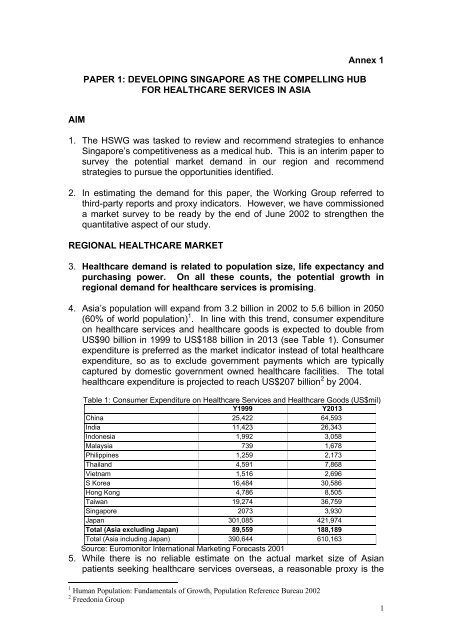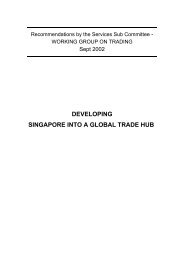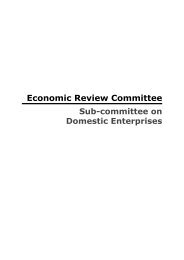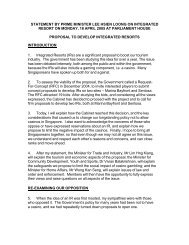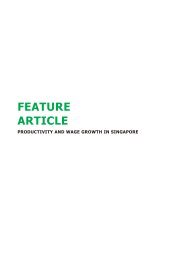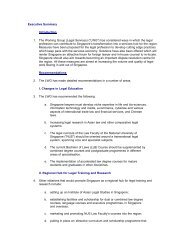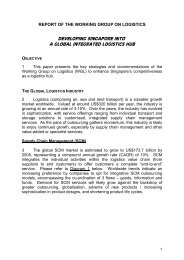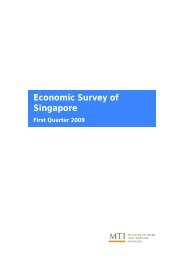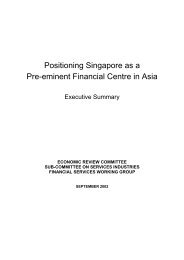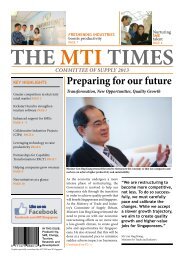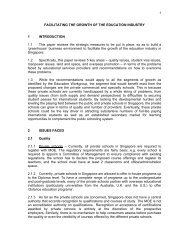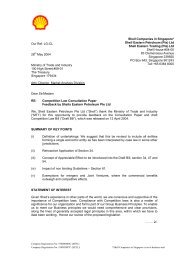Annex 1 - Ministry of Trade and Industry
Annex 1 - Ministry of Trade and Industry
Annex 1 - Ministry of Trade and Industry
Create successful ePaper yourself
Turn your PDF publications into a flip-book with our unique Google optimized e-Paper software.
<strong>Annex</strong> 1<br />
PAPER 1: DEVELOPING SINGAPORE AS THE COMPELLING HUB<br />
FOR HEALTHCARE SERVICES IN ASIA<br />
AIM<br />
1. The HSWG was tasked to review <strong>and</strong> recommend strategies to enhance<br />
Singapore’s competitiveness as a medical hub. This is an interim paper to<br />
survey the potential market dem<strong>and</strong> in our region <strong>and</strong> recommend<br />
strategies to pursue the opportunities identified.<br />
2. In estimating the dem<strong>and</strong> for this paper, the Working Group referred to<br />
third-party reports <strong>and</strong> proxy indicators. However, we have commissioned<br />
a market survey to be ready by the end <strong>of</strong> June 2002 to strengthen the<br />
quantitative aspect <strong>of</strong> our study.<br />
REGIONAL HEALTHCARE MARKET<br />
3. Healthcare dem<strong>and</strong> is related to population size, life expectancy <strong>and</strong><br />
purchasing power. On all these counts, the potential growth in<br />
regional dem<strong>and</strong> for healthcare services is promising.<br />
4. Asia’s population will exp<strong>and</strong> from 3.2 billion in 2002 to 5.6 billion in 2050<br />
(60% <strong>of</strong> world population) 1 . In line with this trend, consumer expenditure<br />
on healthcare services <strong>and</strong> healthcare goods is expected to double from<br />
US$90 billion in 1999 to US$188 billion in 2013 (see Table 1). Consumer<br />
expenditure is preferred as the market indicator instead <strong>of</strong> total healthcare<br />
expenditure, so as to exclude government payments which are typically<br />
captured by domestic government owned healthcare facilities. The total<br />
healthcare expenditure is projected to reach US$207 billion 2 by 2004.<br />
Table 1: Consumer Expenditure on Healthcare Services <strong>and</strong> Healthcare Goods (US$mil)<br />
Y1999<br />
Y2013<br />
China 25,422 64,593<br />
India 11,423 26,343<br />
Indonesia 1,992 3,058<br />
Malaysia 739 1,678<br />
Philippines 1,259 2,173<br />
Thail<strong>and</strong> 4,591 7,868<br />
Vietnam 1,516 2,696<br />
S Korea 16,484 30,586<br />
Hong Kong 4,786 8,505<br />
Taiwan 19,274 36,759<br />
Singapore 2073 3,930<br />
Japan 301,085 421,974<br />
Total (Asia excluding Japan) 89,559 188,189<br />
Total (Asia including Japan) 390,644 610,163<br />
Source: Euromonitor International Marketing Forecasts 2001<br />
5. While there is no reliable estimate on the actual market size <strong>of</strong> Asian<br />
patients seeking healthcare services overseas, a reasonable proxy is the<br />
1 Human Population: Fundamentals <strong>of</strong> Growth, Population Reference Bureau 2002<br />
2 Freedonia Group<br />
1
4.8 million high-income Asian households (see Table 2) with income<br />
above US$50,000 p.a. This number will continue to grow, considering the<br />
medium-term growth outlook <strong>of</strong> 3-5% for Southeast Asia <strong>and</strong> 5-7% for<br />
China <strong>and</strong> India.<br />
Table 2: Number <strong>of</strong> Households Earning US$50,000 P.A. or more (‘000)<br />
Y2000 Y2005 Y2010<br />
India 1,109 1,540 2,275<br />
Australia 1,157 1,344 1,586<br />
China 1 3 25<br />
Hong Kong 482 702 912<br />
Indonesia 0 0 0<br />
Malaysia 76 96 145<br />
Philippines 37 51 69<br />
Singapore 241 394 559<br />
South Korea 492 802 1,281<br />
Taiwan 1,170 1,285 1,624<br />
Thail<strong>and</strong> 42 63 116<br />
Japan 28,388 23,468 25,701<br />
Total (Asia excluding<br />
4,807 6,280 8,592<br />
Japan)<br />
Total (Asia including<br />
33,195 29,748 34,293<br />
Japan)<br />
Source: Asian Demographics<br />
SINGAPORE’S FOREIGN PATIENT 3 MARKET TODAY<br />
6. Based on Singapore Tourism Board (STB)’s overseas visitors’ surveys,<br />
there were approximately 150,000 foreign patients 4 seeking treatment in<br />
Singapore in year 2000. They incurred about S$345 million a year 5 in<br />
healthcare expenditure. As a reference point, foreign patients travelling<br />
to the US for medical treatment generated some US$915 million <strong>of</strong><br />
“export” revenues in 1998 6 . Equally useful is the fact that its regional<br />
medical hubs see a large number <strong>of</strong> out-<strong>of</strong>-state patients. For example,<br />
Mayo Clinic’s patient load comprises 30% out-<strong>of</strong>-state patients <strong>and</strong> 5-6%<br />
foreign patients each year.<br />
7. MOH has administrative records <strong>of</strong> all hospital admissions for inpatient<br />
<strong>and</strong> day surgery 7 . Based on MOH’s data (see Figure 1), the number <strong>of</strong><br />
foreign patients dipped significantly during the Asian financial crisis.<br />
Whilst the market has rebounded, it has not caught up with the pre-1998<br />
growth trajectory 8 .<br />
Figure 1<br />
3 Foreign = Non-resident<br />
4 STB surveys 10,000 visitors at airport departure lounges. The result <strong>of</strong> the survey is extrapolated to<br />
the entire 6 million visitors to Singapore, by road, sea <strong>and</strong> air.<br />
5 Calculated based on data collected from STB’s overseas visitors’ survey.<br />
6 US <strong>Trade</strong> <strong>and</strong> <strong>Industry</strong> Outlook 2000<br />
7 Foreign patients can be viewed as three categories: inpatient, day surgery <strong>and</strong> outpatient.<br />
8 In line with the industry trend towards ambulatory surgery, day surgery patient numbers have<br />
exp<strong>and</strong>ed at a faster pace since 1991 compared to inpatient admissions.<br />
2
No.<br />
18,000<br />
16,000<br />
14,000<br />
12,000<br />
10,000<br />
In-Patients<br />
14,010<br />
13,291<br />
12,012 12,377<br />
12,801<br />
Day Surgery Patients<br />
15,844 16,418 12,646 12,817<br />
10,698<br />
Lost<br />
opportunity:<br />
5,183 patients<br />
minus 28.8%*<br />
8,000<br />
6,000<br />
4,000<br />
2,000<br />
0<br />
733<br />
5,017 5,844<br />
1,954 2,828 3,156 3,860 4,293 5,002<br />
3,567<br />
1991 1992 1993 1994 1995 1996 1997 1998 1999 2000<br />
Lost<br />
opportunity:<br />
2,998<br />
patients<br />
* Based on year 2000 projected data against current data<br />
Source: STB overseas visitors’ survey <strong>and</strong> MOH administrative records<br />
8. The dip could be related to our reliance on traditional markets which were<br />
affected by the regional crisis. Indonesians <strong>and</strong> Malaysians account for<br />
70-85% <strong>of</strong> Singapore’s foreign patients (see Table 3).<br />
Table 3: Foreign Patients by Nationality<br />
Nationality MOH inpatient data STB Survey<br />
Indonesia 45.0% 74.0%<br />
Malaysia 23.7% 10.0%<br />
US/ Canada 4.1% NA<br />
India/ Pakistan/ Sri Lanka 3.2% NA<br />
Brunei 1.7% NA<br />
Other Nationalities 22.3% 16.0%<br />
Source: MOH inpatient admissions (average from year 1996-2000) <strong>and</strong> STB survey (year<br />
2000)<br />
3
9. On the bright side, there is still a positive perception <strong>of</strong> Singapore’s<br />
healthcare services among patients <strong>and</strong> pr<strong>of</strong>essionals in the region.<br />
STB’s survey showed that 72% <strong>of</strong> foreign patients chose Singapore for<br />
its high quality, whilst 31% <strong>of</strong> patients were recommended or referred to<br />
seek treatment here 9 .<br />
10. Singapore is a broad-based medical hub. Foreign patients chose a<br />
wide range <strong>of</strong> specialty areas for both in-patient <strong>and</strong> day surgery<br />
treatment. Relative to the region, we have expertise in Cardiology,<br />
Oncology, Urology <strong>and</strong> Obstetrics, as shown by the proportionately higher<br />
foreign patient attendance in these specialties. Foreign outpatient cases<br />
spanned gynaecological consultation, physical examination, <strong>and</strong> eye<br />
check-up.<br />
11. Singapore’s healthcare providers have capabilities throughout the<br />
continuum <strong>of</strong> services, from primary to secondary, tertiary <strong>and</strong><br />
quaternary care. Both restructured hospital clusters, SingHealth <strong>and</strong><br />
National Health Group, span the whole continuum, whilst the two leading<br />
private healthcare groups, Parkway <strong>and</strong> Raffles Medical, focus mainly on<br />
primary to tertiary services.<br />
TARGETS AND THE ECONOMIC BENEFITS<br />
12. In year 2000, we estimate that Singapore captured less than 1% <strong>of</strong> the<br />
well-heeled Asian market for healthcare services. We aim to exp<strong>and</strong> our<br />
market share to 2% by 2007 <strong>and</strong> 3% by 2012 (see Table 4). Taking into<br />
account the projected growth in the number <strong>of</strong> Asian households with<br />
more than US$50,000 income, this suggests a total <strong>of</strong> 1 million foreign<br />
patient visitors per annum by 2012 with 100,000 foreign patient<br />
admissions. This would generate S$3.0 billion in healthcare expenditure<br />
or close to S$2.6 billion in value-added to the Singapore economy, <strong>and</strong><br />
could create some 13,000 jobs 10 , a significant proportion <strong>of</strong> whom would<br />
be for paramedical <strong>and</strong> nursing manpower.<br />
Table 4: 2007 <strong>and</strong> 2012 Targets (T)<br />
Y1996 Y2000 Y2007 (T) Y2012 (T)<br />
Share <strong>of</strong> Asian market - ^1% 2% 3%<br />
Foreign Patients<br />
Total<br />
Inpatient/day surgery<br />
CAGR <strong>of</strong> Total<br />
Expenditure<br />
Total<br />
Foreign patients<br />
Accompanying tourist<br />
Value Added<br />
Total<br />
Healthcare<br />
Tourism<br />
% VA contribution to GDP<br />
Total<br />
Healthcare<br />
89,000<br />
21,000<br />
-<br />
147,000<br />
18,000<br />
+13%<br />
- $430 mil<br />
$350 mil<br />
$80 mil<br />
- $370 mil<br />
$320mil<br />
$50 mil<br />
-<br />
0.25%<br />
0.20%<br />
500,000<br />
50,000<br />
+28%<br />
$1,500 mil<br />
$1,200 mil<br />
$300 mil<br />
$1,300mil<br />
$1,100 mil<br />
$200 mil<br />
0.65%<br />
0.55%<br />
1,000,000<br />
100,000<br />
+16%<br />
$3,000 mil<br />
$2,400 mil<br />
$600 mil<br />
$2,600 mil<br />
$2,200 mil<br />
$400 mil<br />
1.10%<br />
0.95%<br />
9 STB overseas visitors survey<br />
10 This assumes that healthcare sector productivity stays constant.<br />
4
Tourism 0.05% 0.10% 0.15%<br />
Cumulative Healthcare jobs - Base year 5,100 13,000<br />
creation<br />
13. The targets are feasible, since it means that each specialist will only be<br />
seeing 2 foreign patients per day in year 2012, compared to 0.4 in 2000.<br />
There is also adequate bed capacity, as private sector hospitals currently<br />
have occupancy rates <strong>of</strong> less than 50%.<br />
14. In addition to the direct economic contribution, a vibrant healthcare<br />
services industry would be a key str<strong>and</strong> <strong>of</strong> a multi-faceted, mutually<br />
reinforcing Services sector. For instance, foreign patients are usually<br />
accompanied by close ones. STB estimates that each S$1 spent by a<br />
visitor generates $0.63 to the Singapore economy. Hence, this could<br />
generate an additional $578 million <strong>of</strong> tourist expenditures per annum or<br />
$364 million <strong>of</strong> VA by 2012. In total, the 1 million <strong>of</strong> foreign patients<br />
would bring about more than $3 billion in expenditures, contributing<br />
more than 1% in value-added to Singapore’s GDP. Moreover, the<br />
doctor-patient relationship is “sticky” i.e., it would generate a higher<br />
proportion <strong>of</strong> repeat visits.<br />
15. A vibrant healthcare services industry also anchors Singapore’s<br />
initiative to develop <strong>and</strong> exp<strong>and</strong> the Biomedical Sciences sector. To<br />
maintain Singapore’s leadership position <strong>and</strong> reputation for excellence in<br />
healthcare services, our clinicians need access to the latest <strong>and</strong> most<br />
advanced therapies <strong>and</strong> diagnostics. Likewise, biomedical product<br />
development will be successful only if it solves clinical problems <strong>and</strong> can<br />
be translated from the laboratory to the clinical setting. This requires a<br />
close synergy between the clinicians <strong>and</strong> the biomedical researchers.<br />
16. In addition to attracting high net-worth foreign patients to Singapore,<br />
Singapore healthcare providers should pursue opportunities in the<br />
region to capture the big <strong>and</strong> growing Asian middle class market that seek<br />
healthcare services locally (as opposed to travelling overseas). There is<br />
potential to build Singapore MNCs in this sector. Parkway <strong>and</strong> Raffles<br />
Medical Group are already in the list <strong>of</strong> top 15 healthcare service players<br />
in Asia (including Australia) (see Table 5). This list excludes SingHealth<br />
<strong>and</strong> National Healthcare Group.<br />
Table 5: Internationalization <strong>of</strong> Singapore-based Healthcare Enterprises<br />
Rank Company Country Sales<br />
(US$)<br />
Market Cap<br />
(US$)<br />
1 Health Care <strong>of</strong> Australia 553.7 638.7<br />
Australia<br />
2 Nichii Gakkan Japan 535.1 3,768.1<br />
3 Parkway Holdings Singapore 228.3 1,003.6<br />
4 Australian Hospital Australia 193.2 53.9<br />
Care<br />
5 Ramsay Healthcare Australia 156.6 57.1<br />
6 Sonic Healthcare Australia 107.5 610.3<br />
7 Prasit Patana Thail<strong>and</strong> 51.5 0.6<br />
8 Healthscope Australia 65.0 5.9<br />
9 Alpha Healthcare Australia 59.2 219.8<br />
10 Bumrungrad Hospital Thail<strong>and</strong> 42.6 5.7<br />
5
11 Bangkok Dusit Medical Thail<strong>and</strong> 36.3 15.1<br />
12 Pantai Holdings Malaysia 30.1 186.3<br />
Berhad<br />
13 Samitivej Public Thail<strong>and</strong> 27.9 5.2<br />
14 Raffles Medical Singapore 31.4 279.3<br />
15 KPJ Healthcare Malaysia 28.3 40.8<br />
Berhad<br />
Source: Economic Intelligence Unit Healthcare Asia Report - 1st Quarter 2000<br />
REGIONAL COMPETITION<br />
17. Since the Asian financial crisis, other countries have aggressively<br />
marketed themselves as medical tourism destinations. Singapore may<br />
have lost market share as shown by the shaded area in Figure 1. The<br />
likely reasons are:<br />
(a) Improvement in the capabilities <strong>and</strong> management <strong>of</strong> our competitors,<br />
narrowing the gap compared to Singapore. For example, a growing<br />
number <strong>of</strong> regional hospitals are now managed by experienced foreign<br />
operators.<br />
(b) Bumrungrad Hospital in particular, has gone on a marketing blitz all over<br />
Asia. Thai tour operators have also participated in this boom, <strong>of</strong>fering<br />
“check-in <strong>and</strong> check-up” packages with their usual fare.<br />
(c) Low cost. Their marketing messages consistently emphasise that their<br />
prices are cheaper than Singapore. In Malaysia’s case, a 1998 bill to<br />
safeguard against over-charging at private hospitals <strong>and</strong> clinics have also<br />
helped 11 .<br />
18. Nevertheless, Singapore is still perceived to set the st<strong>and</strong>ard for<br />
quality healthcare. Our clinicians <strong>and</strong> hospitals have achieved some<br />
well-publicised medical breakthroughs such as the separation <strong>of</strong> the<br />
Siamese twins, cord blood transplantation, etc. Doctors from the region<br />
also continue to refer their patients to Singapore.<br />
RECOMMENDATIONS: HOW TO COMPETE<br />
POSITIONING<br />
19. Develop a compelling hub with two mutually reinforcing elements<br />
(a) Clinical Medical Hub: Extend our lead over regional competitors in terms<br />
<strong>of</strong> medical expertise, to differentiate Singapore from the competition.<br />
Institutions such as Mayo Clinic exemplify the Clinical Medical hub, with an<br />
enduring br<strong>and</strong> name built on service, research <strong>and</strong> educational<br />
excellence. As a result, it has extensive market reach <strong>of</strong> about 10,000<br />
patients from 120 countries, generating $5.5 billion worth <strong>of</strong> revenues a<br />
year 12 . Its reputation for cutting edge medicine allows it to comm<strong>and</strong> a<br />
price premium for even primary care services, for example, charging<br />
$25,000 for a general medical examination.<br />
11 The Private Health Care Services & Facilities Act 1998.<br />
12 Sources: ST, 14 December 2001; Mayo website<br />
6
(b) Economic Medical Hub: Attract large volume <strong>and</strong> high throughput <strong>of</strong><br />
patients for economic impact <strong>and</strong> economies <strong>of</strong> scale. The bulk <strong>of</strong> the<br />
dem<strong>and</strong> is for “bread <strong>and</strong> butter” secondary care, relative to tertiary or<br />
quaternary care. “Amortising” investments in expensive equipment <strong>and</strong><br />
scarce medical expertise over a larger number <strong>of</strong> patients reduces the<br />
average cost <strong>and</strong> enhances cost-competitiveness. Furthermore, this<br />
provides the critical mass for management initiatives to focus on<br />
productivity <strong>and</strong> process improvements.<br />
NATIONAL MARKETING INITIATIVE:<br />
TO REGAIN MINDSHARE AS THE REGION’S MEDICAL HUB<br />
20. A key factor behind Bumrungrad Hospital’s rapid growth is arguably its<br />
aggressive marketing. With rising consumer affluence <strong>and</strong> the growing<br />
competition, it is necessary for Singapore to undertake a coordinated<br />
marketing initiative to attract foreign patients, <strong>and</strong> build robust facilitation<br />
processes <strong>and</strong> referral networks in the region. This would include the<br />
following:<br />
(a) Review the regulations in the Public Hospitals <strong>and</strong> Medical Clinics<br />
Act (PHMCA) with a view to relax restrictions on responsible, institutionbased<br />
advertising locally <strong>and</strong> abroad.<br />
(b) Establish <strong>and</strong> communicate an internationally recognisable quality<br />
br<strong>and</strong> for Singapore’s healthcare services sector emphasising trust, safety<br />
<strong>and</strong> excellence. This would complement the marketing efforts <strong>of</strong> individual<br />
healthcare institutions.<br />
(c) Strengthen price transparency by publishing data on pr<strong>of</strong>essional fees<br />
charged by various specialists, estimated hospital bill size, <strong>and</strong> the prices<br />
<strong>of</strong> drugs <strong>and</strong> other items.<br />
(d) Establish one-stop centres in key regional markets to make it more<br />
convenient for foreign patients to come to Singapore. The centres would<br />
assist potential patients with visa applications, finding suitable doctors <strong>and</strong><br />
accommodation in Singapore, etc. The one-stop centre would also market<br />
Singapore’s healthcare services to target groups such as expatriates;<br />
organise medical trade missions; <strong>and</strong> host “familiarisation” trips for<br />
regional doctors to visit Singapore. London Medicine <strong>and</strong> AusHealth are<br />
two organisations set up for similar purposes.<br />
(e) Streamline the immigration process to meet the needs <strong>of</strong> medical<br />
visitors e.g. pre-approved visas for elective surgery cases, <strong>and</strong> expedited<br />
approval for emergencies.<br />
(f) Exp<strong>and</strong> the regional referral network by:<br />
• Leveraging on doctors from the region who have trained in Singapore<br />
• Hosting international / regional medical conferences <strong>and</strong> exhibitions <strong>and</strong><br />
training visits. For instance, in 2000, Singapore played host to 31 such<br />
healthcare events.<br />
• Investing in regional hospitals <strong>and</strong> clinics.<br />
7
REDUCE MANPOWER SUPPLY RIGIDITIES:<br />
TO ENHANCE COST-COMPETITIVENESS<br />
21. Manpower expense is the major cost component in the healthcare<br />
industry, accounting for about 44% <strong>of</strong> the industry’s operating<br />
expenditure 13 . Unless manpower supply or efficiency increases in t<strong>and</strong>em<br />
with the growth in dem<strong>and</strong>, cost pressures will mount, thus further eroding<br />
our competitiveness vis-à-vis neighbouring countries.<br />
(a) Various studies including the Medical Education Review Panel have<br />
concluded that there is a need to increase the supply <strong>of</strong> doctors in<br />
Singapore. Short-term responses include a re-opening <strong>of</strong> the medical<br />
register (the list <strong>of</strong> recognised medical degrees) to the pre-1993 list 14 ; <strong>and</strong><br />
establishing clear processes for accreditation <strong>of</strong> foreign doctors. A longer<br />
term solution would be to increase the number <strong>of</strong> doctors trained in<br />
Singapore via the proposed NUS-SGH Graduate Medical Programme.<br />
(b) Optimise the use <strong>of</strong> limited medical expertise. There is currently a<br />
shortage <strong>of</strong> doctors relative to patient load in the public sector compared to<br />
the private sector (see Table 6).<br />
Table 6: Distribution <strong>of</strong> Doctors <strong>and</strong> Patients in Singapore<br />
Private<br />
Public/Restructured<br />
% <strong>of</strong> total Number % <strong>of</strong> total Number<br />
Total Doctors 52% 2,809 48% 2,586<br />
Specialists 45% 856 55% 1,036<br />
Inpatient Admissions 21% 82,500 79% 305,532<br />
Average inpatient<br />
96 295<br />
admissions per<br />
specialist<br />
Source: MOH, Singapore Accreditation Board<br />
• To address this, a common practice in Australia is for doctors to hold<br />
dual appointments in the public <strong>and</strong> private sector, thus catering to the<br />
needs <strong>of</strong> both cost-sensitive patients <strong>and</strong> comfort-conscious patients.<br />
Visiting Consultants 15 <strong>and</strong> the Faculty Practice Plan 16 represent positive<br />
steps towards this. Such arrangements should be implemented on a wider<br />
scale to even out the manpower distribution impactfully, e.g. by allowing<br />
every public sector doctor to work up to a specified proportion <strong>of</strong> their time,<br />
say 30%, in the private sector.<br />
• The Government could make greater use <strong>of</strong> private practitioners to<br />
provide public healthcare services to Singaporeans. For example,<br />
under the Primary Care Partnership Scheme, public polyclinics engage<br />
private GPs to provide outpatient healthcare services to needy elderly.<br />
The patients pay polyclinic charges <strong>and</strong> the government provides a<br />
subsidy to participating GPs.<br />
13 Source: Department <strong>of</strong> Statistics, for Year 1999<br />
14 After 1993, the number <strong>of</strong> <strong>of</strong>ficially recognized foreign medical schools was reduced from 178 to 28.<br />
15 Private practitioners spend a portion <strong>of</strong> time in the public sector<br />
16 Public sector doctors spend a portion <strong>of</strong> time in the private sector. By giving public sector doctors<br />
“the best <strong>of</strong> both worlds” it may help to retain them in the public sector.<br />
8
This model can be progressively extended to inpatient services in the<br />
future. Patients are subsidised up to a fixed amount, with which they can<br />
choose to be treated in public or private hospitals. Conceptually, this will<br />
represent a repositioning <strong>of</strong> the Government’s role from being a provider <strong>of</strong><br />
healthcare services to that <strong>of</strong> a buyer <strong>of</strong> services for its citizens.<br />
Added benefits include lower prices <strong>and</strong> better service for consumers<br />
arising from the greater competition. Enabling subsidized patients to<br />
choose their care providers, albeit with varying levels <strong>of</strong> co-payment,<br />
would also help to neutralize the concern regarding the “demonstration<br />
effect” 17 .<br />
(c) Attract a larger supply <strong>of</strong> nursing <strong>and</strong> paramedical manpower, with<br />
more progressive career paths. Restructure their functions with a view to<br />
optimise their roles so as to enhance efficiency <strong>and</strong> job satisfaction.<br />
(d) Facilitate recruitment <strong>of</strong> foreign nursing <strong>and</strong> paramedical manpower.<br />
• To retain nursing <strong>and</strong> paramedical manpower, the income criteria for<br />
granting such applicants Q1 employment passes should be relaxed.<br />
This would enable their family to live in Singapore.<br />
• Empower approved healthcare providers to recruit qualified<br />
paramedical manpower <strong>and</strong> be responsible for their st<strong>and</strong>ards. This<br />
would streamline the employment pass application process by<br />
removing the need for the <strong>Ministry</strong> <strong>of</strong> Manpower to seek MOH's inputs.<br />
FISCAL INCENTIVES<br />
22. We recommend the introduction <strong>of</strong><br />
• Group relief<br />
• Concessionary tax rate for income generated from the provision <strong>of</strong><br />
healthcare services to non-resident patients<br />
• Zero-rating on GST for healthcare services<br />
• Removal <strong>of</strong> withholding tax on fees earned by visiting specialists, as well<br />
as<br />
• Institutional zoning for l<strong>and</strong> occupied by hospitals.<br />
These fiscal incentives together with the recommendations in para 21<br />
above will help enhance our cost competitiveness.<br />
CONCLUSION AND NEXT STEP<br />
23. Regional dem<strong>and</strong> for healthcare will rise in t<strong>and</strong>em with the projected<br />
trends <strong>of</strong> rising population, life expectancy <strong>and</strong> purchasing power in Asia.<br />
We aim to exp<strong>and</strong> Singapore’s share <strong>of</strong> this growing market from just<br />
under 1% today to 3% by 2012. This would represent 1 million foreign<br />
patients contributing some $2.6 billion <strong>of</strong> VA to our GDP.<br />
17 The “demonstration” effect refers to the concern that subsidized local patients may dem<strong>and</strong> the<br />
public sector to provide the levels <strong>of</strong> care <strong>and</strong> convenience that non-subsidized foreign patients receive<br />
in the private sector.<br />
9
24. Singapore can compete by emphasizing the twin aspects <strong>of</strong> being a<br />
Clinical Medical Hub <strong>and</strong> Economic Medical Hub, which interact in a<br />
synergistic way. A national marketing initiative <strong>and</strong> the restructuring <strong>of</strong><br />
supply rigidities to enhance cost-competitiveness, are key imperatives.<br />
25. HSWG will submit a second paper to the ERC to address the implications<br />
<strong>of</strong> our medical hub ambition on other national objectives. These include:<br />
(a) The concern that the promotion <strong>of</strong> healthcare services to attract foreign<br />
patients could inadvertently spur dem<strong>and</strong> for unnecessary services by<br />
local patients, <strong>and</strong> cause local healthcare costs to rise;<br />
(b) The concern that subsidized local patients may dem<strong>and</strong> the public sector<br />
to provide the levels <strong>of</strong> care <strong>and</strong> convenience that full paying foreign<br />
patients receive in the private sector;<br />
(c) The need to ensure that an increase in the supply <strong>of</strong> doctors to respond to<br />
the rising dem<strong>and</strong> does not impact negatively the Government’s effort to<br />
have an even spread <strong>of</strong> Singapore’s indigenous talent pool to the different<br />
pr<strong>of</strong>essions <strong>and</strong> jobs; <strong>and</strong><br />
(d) The need to ensure that healthcare R&D continues to be supported so that<br />
Singapore healthcare services sector can excel <strong>and</strong> be a source <strong>of</strong><br />
competitive advantage. This objective <strong>of</strong> being a Clinical Medical Hub is<br />
also synergistic with the national thrust to develop the research-intensive<br />
Biomedical Sciences industry as a key pillar <strong>of</strong> the Singapore economy.<br />
END<br />
10
Healthcare Services Working Group (HSWG) members<br />
Dr. Loo Choon Yong (Chair)<br />
Mr. Ko Kheng Hwa<br />
Pr<strong>of</strong>. Lee Eng Hin<br />
Ms. Leong Wai Leng<br />
Dr. Lim Cheok Peng<br />
Mr. Lim Hock San<br />
Pr<strong>of</strong>. Lim Yean Leng<br />
Mr. Tan Beng Lee<br />
Pr<strong>of</strong>. Tan Ser Kiat<br />
Mr. Tan Tee How<br />
Dr. Kanwaljit Soin<br />
Mr. Yeo Khee Leng<br />
Executive Chairman, Raffles Medical Group<br />
Managing Director, Economic Development Board<br />
Dean, Faculty <strong>of</strong> Medicine, National University <strong>of</strong> Singapore<br />
COO, Raffles Holding Ltd<br />
Managing Director, Parkway Group Healthcare<br />
President <strong>and</strong> CEO, UIC Ltd<br />
Director, National Heart Centre<br />
Group CEO, Great Eastern Life Pte Ltd<br />
Group CEO, Singapore Health Services Pte Ltd<br />
CEO, National Healthcare Group Pte Ltd<br />
Consultant Surgeon, Orthopaedic, Spine & H<strong>and</strong> Surgery Pte Ltd<br />
CEO, Singapore Tourism Board<br />
HSWG Secretariat members<br />
Dr. Beh Swan Gin<br />
Ms. Loh Chin Siew<br />
Ms. Lynette Lee<br />
Ms. Shirley Loo<br />
Mrs. Phoon Chew Ping<br />
2 Director, Biomedical Sciences, EDB<br />
Head, Biomedical Sciences, EDB<br />
Senior Officer, Biomedical Sciences, EDB<br />
Senior Officer, Strategic Planning, EDB<br />
Director, Strategic Planning, MOH<br />
Dy Director, Strategic Planning, MOH<br />
General Manager, Raffles Hospital<br />
Business Development Manager, Raffles Medical Group<br />
Mr. Han Kok Juan<br />
Mr. Lawrence Lim<br />
Mr. David Lee<br />
11
HSWG Sub-Group members<br />
Ms. Karen Koh<br />
Mr. Nicholas Miao<br />
Mr. Tan Wah Yeow<br />
Ms. Hilda Yap<br />
Mr. Art Ouellette<br />
Ms. Tan Keet Yee<br />
Mr. Allan Yeo Hwee Tiong<br />
Dr. Djeng Shih Kian<br />
Dr. Nei I Ping<br />
Mrs. Cecilia Tan<br />
Dr. Richard Ng<br />
Ms. Cecilia Chua<br />
Pr<strong>of</strong>. Soo Khee Chee<br />
A/Pr<strong>of</strong>. P C Wong<br />
Ms. Quay Keng Wah<br />
HSWG Dialogue Session participants<br />
Dr.<br />
Ang Chong Lye<br />
Ms.<br />
Boo Hui Yun<br />
Mr.<br />
Howard Califano<br />
Ms.<br />
Chan Mun Yee<br />
A/Pr<strong>of</strong>.<br />
Chan Yew Weng<br />
Pr<strong>of</strong>.<br />
Charles Ng<br />
Pr<strong>of</strong>.<br />
Chee Yam Cheng<br />
Dr.<br />
Christopher Cheng<br />
Mr.<br />
Cheng Sim Kim<br />
Dr.<br />
Cheng Wei Chen<br />
Mr.<br />
Chi Cheng Hock<br />
Dr.<br />
Allan Chin<br />
Ms.<br />
Annie Chin<br />
Mr.<br />
Dr.<br />
Lee Suan Yew<br />
Mr.<br />
Leong Yew Meng<br />
Mr.<br />
Liak Teng Lit<br />
Dr.<br />
Lim Kian Peng<br />
Dr.<br />
Lawrence Lim<br />
Dr.<br />
Lim Suet Wun<br />
Pr<strong>of</strong>.<br />
Lim Yean Leng<br />
Mr.<br />
SR Lo<br />
Pr<strong>of</strong>.<br />
Low Cheng Hock<br />
Dr.<br />
Low Cze Hong<br />
Dr.<br />
Nyam Ngian Kwong, Denis<br />
Dr.<br />
Brian O Keeffe<br />
A/Pr<strong>of</strong>.<br />
Ong Kian Chung, Benjamin<br />
Pr<strong>of</strong>.<br />
12
Chong Teng Kim<br />
Dr.<br />
Vincent Chong<br />
Dr.<br />
William Chong<br />
Dr.<br />
S<strong>and</strong>ra Chu<br />
A/Pr<strong>of</strong>.<br />
Fock Kwong Ming<br />
Mr.<br />
William Fong<br />
Mr.<br />
Goh Chye Tee<br />
Dr.<br />
Anthony Heng<br />
Dr.<br />
Ho Kee Hang<br />
Dr.<br />
Werner Katzmann<br />
Dr.<br />
Khoo Kei Siong<br />
Dr.<br />
Philomena Koh<br />
Dr.<br />
Kua Ee Heok<br />
Dr.<br />
Prem Kumar<br />
Dr.<br />
Kwa Chong Teck<br />
Dr.<br />
Laslie Lam<br />
Dr.<br />
Lau Hong Choon<br />
Mr.<br />
Augustin Lee<br />
Mr.<br />
Lee Cheow Seng<br />
Ong Yong Yau<br />
Dr.<br />
Phua Kai Hong<br />
Ms.<br />
Rosalind Phuan<br />
Mr.<br />
Sia K H<br />
A/Pr<strong>of</strong>.<br />
Sim Kwang Wei, Eugene<br />
Mr.<br />
Peter Sng<br />
Dr.<br />
Arthur Tan<br />
Dr.<br />
Clarence Tan<br />
A/Pr<strong>of</strong>.<br />
Donald Tan<br />
Dr.<br />
Tan Khai Tong<br />
Mr.<br />
Tan Khye Hua<br />
Mr.<br />
Tan Kin Lian<br />
Ms.<br />
Tan Mui Ling<br />
Mr.<br />
Sebastian Tan<br />
Dr.<br />
Tan Yew Oo<br />
A/Pr<strong>of</strong>.<br />
Tay Boon Keng<br />
Mr.<br />
T K Udairam<br />
Dr.<br />
Ellick Wong<br />
Ms.<br />
Yeo Lei Noy<br />
Mr.<br />
Paul Yong<br />
13


